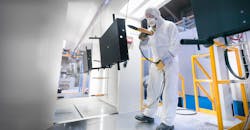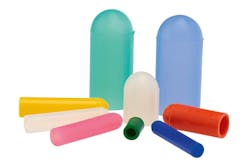What’s the Difference Between EPDM and Silicone When it Comes to Masking?
Masking is an essential part of the production and finishing process for manufacturers, fabricators, and machine builders. It is used in shot blasting, powder coating, e-coating, anodizing, plating, and wet painting, and can come in the form of masking caps, masking plugs, and masking tape. The key to success is selecting an appropriate material suited to your operating temperature and application process. Two commonly used masking materials are silicone and ethylene propylene diene monomer rubber, more widely known as EPDM. Some engineers and designers are confused as to when each of these should be used. Here’s some guidance that should set them straight
EPDM
EPDM has a stable, saturated polymer backbone structure, which gives the material its advantages. For example, of all the rubbers, EPDM is the most water resistant. This makes it popular for outdoor applications and is often used as a roofing material. EPDM also stands up to harsh weather conditions such as sleet and snow. Another reason for its use outdoors, particularly in construction, is its high level of resistance to abrasions and tears and the ability to stand up to the degrading effects of weathering, ozone, and UV ray exposure.
EPDM also offers good electrical resistivity. Its chemical properties make it especially suitable for electrical insulation and gaskets. It resists polar solvents—not just water, but also acids, alkalies, and phosphate esters. EDPM does a great job of withstanding steam, along with low and high temperatures, though silicone can take on even higher temperatures. The material has a low compression set, so it does not lose much resilience despite prolonged pressure.
Silicone
Silicone is a food-safe and incredibly versatile material, thanks to its chemistry and the many ways it can be modified. Consequently, it offers vast possibilities.
Perhaps the most appealing characteristic of silicone is that it withstands extremely high temperatures, which is why it’s especially popular for masking applications. Manufacturers will all give different melting points based on their experience and own criteria, but generally silicone can stand up to 450°F (232°C), while EPDM’s top temperature is limited to 300°F (148°C).
Masking Limits
Tapered plugs make masking efficient with quick and easy-to-apply plugs. One size fits several hole sizes, which saves time and inventory space. They are reusable for better value and available as a solid plug or a hollow core to aid in compression. EPDM plugs handle temperatures up to 356°F (180°C) and silicone plugs handle operating temperatures up to 572°F (300°C). They both prevent contamination and have high chemical resistance. EPDM comes in black, while silicone is available in several color-coded sizes.
Straight caps are reusable and cost-effective for protecting studs, pins, and tube ends where they maintain color conformity in the masking process with a choice of a variety of colors in EPDM to 356°F (180°C) or silicone 572°F (300°C). They can be used for either wet painting or high-temperature baking. There are over 200 sizes (different lengths and diameters), making it easy to find just the right size for any application.
Pull plugs for masking make life easier by providing pull tabs that let technicians use to pull the plug though threaded and un-threaded through holes. Thus, they enhance efficiency in production processes by saving time with fast installation and removal. Choose from silicone or EPDM, depending on the application. Both safely protect during anodizing, shot blasting, and painting on hole diameters ranging from 1.6 to 35.1 mm.
Scott Fawcett, managing director at Essentra Components. For questions regarding masking materials, visit www.essentracomponents.co.uk, or [email protected].


